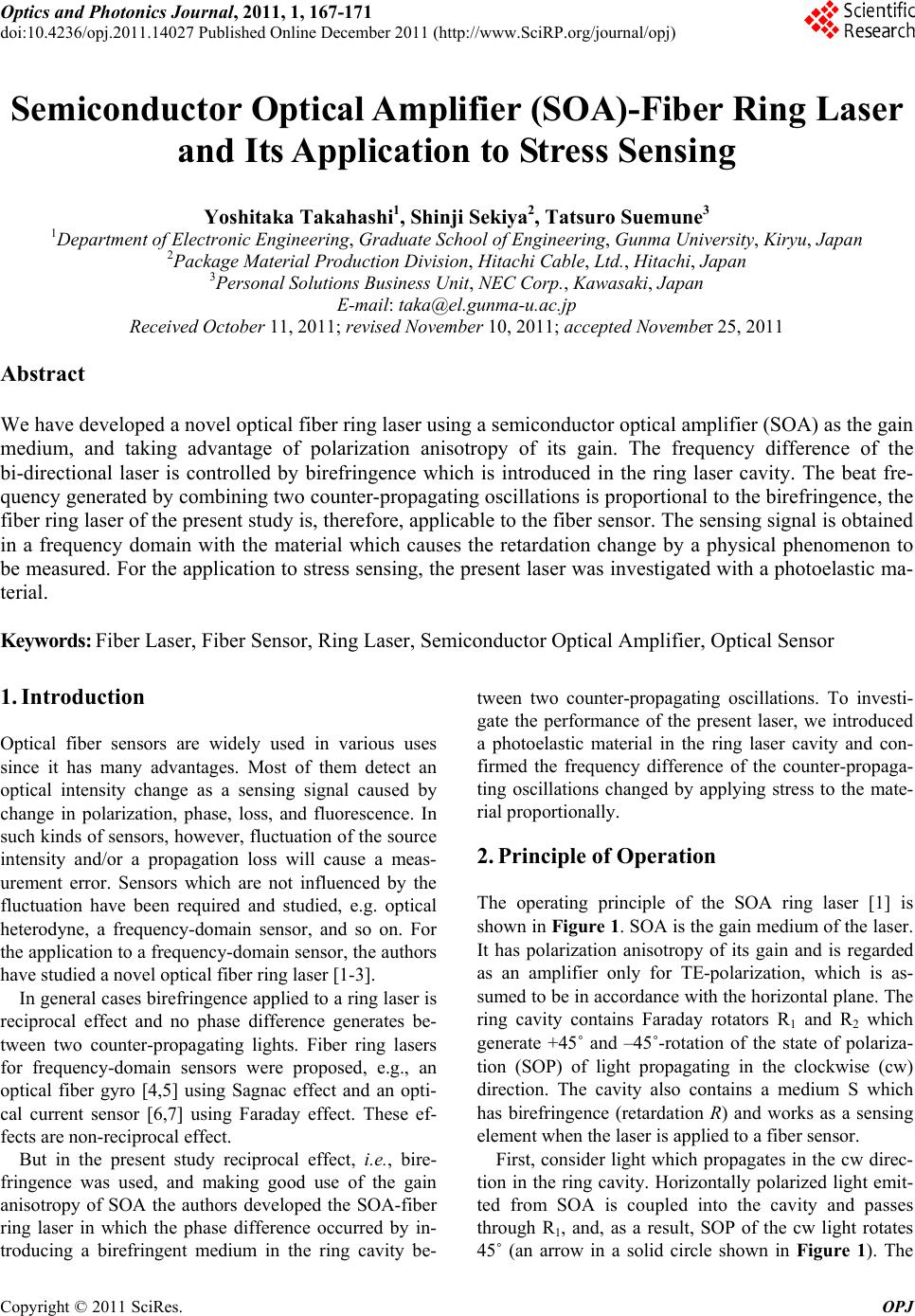
Optics and Photonics Journal, 2011, 1, 167-171
doi:10.4236/opj.2011.14027 Published Online December 2011 (http://www.SciRP.org/journal/opj)
Copyright © 2011 SciRes. OPJ
Semiconductor Optical Amplifier (SOA)-Fiber Ring Laser
and Its Application to Stress Sensing
Yoshitaka Takahashi1, Shinji Sekiya2, Tatsuro Suemune3
1Department of Electronic Engineering, Graduate School of Engineering, Gunma University, Kiryu, Japan
2Package Mate rial Product i o n Di v i sion, Hitachi Cable, Ltd., Hitachi, Japan
3Personal Solutions Business Unit, NEC Corp., Kawasaki, Japan
E-mail: taka@el.gunma-u.ac.jp
Received October 11, 2011; revised November 10, 2011; accepted November 25, 201 1
Abstract
We have developed a novel optical fiber ring laser using a semiconductor optical amplifier (SOA) as the gain
medium, and taking advantage of polarization anisotropy of its gain. The frequency difference of the
bi-directional laser is controlled by birefringence which is introduced in the ring laser cavity. The beat fre-
quency generated by combining two counter-propagating oscillations is proportional to the birefringence, the
fiber ring laser of the present study is, therefore, applicable to the fiber sensor. The sensing signal is obtained
in a frequency domain with the material which causes the retardation change by a physical phenomenon to
be measured. For the application to stress sensing, the present laser was investigated with a photoelastic ma-
terial.
Keywords: Fiber Laser, Fiber Sensor, Ring Laser, Semiconductor Optical Amplifier, Optical Sensor
1. Introduction
Optical fiber sensors are widely used in various uses
since it has many advantages. Most of them detect an
optical intensity change as a sensing signal caused by
change in polarization, phase, loss, and fluorescence. In
such kinds of sensors, however, fluctuation of the source
intensity and/or a propagation loss will cause a meas-
urement error. Sensors which are not influenced by the
fluctuation have been required and studied, e.g. optical
heterodyne, a frequency-domain sensor, and so on. For
the application to a frequency-domain sensor, the authors
have studied a novel optical fiber ring laser [1-3].
In general cases birefringence applied to a ring laser is
reciprocal effect and no phase difference generates be-
tween two counter-propagating lights. Fiber ring lasers
for frequency-domain sensors were proposed, e.g., an
optical fiber gyro [4,5] using Sagnac effect and an opti-
cal current sensor [6,7] using Faraday effect. These ef-
fects are non-reciprocal effect.
But in the present study reciprocal effect, i.e., bire-
fringence was used, and making good use of the gain
anisotropy of SOA the authors developed the SOA-fiber
ring laser in which the phase difference occurred by in-
troducing a birefringent medium in the ring cavity be-
tween two counter-propagating oscillations. To investi-
gate the performance of the present laser, we introduced
a photoelastic material in the ring laser cavity and con-
firmed the frequency difference of the counter-propaga-
ting oscillations changed by applying stress to the mate-
rial proportionally.
2. Principle of Operation
The operating principle of the SOA ring laser [1] is
shown in Figure 1. SOA is the gain medium of the laser.
It has polarization anisotropy of its gain and is regarded
as an amplifier only for TE-polarization, which is as-
sumed to be in accordance with the horizontal plane. The
ring cavity contains Faraday rotators R1 and R2 which
generate +45˚ and –45˚-rotation of the state of polariza-
tion (SOP) of light propagating in the clockwise (cw)
direction. The cavity also contains a medium S which
has birefringence (retardation R) and works as a sensing
element when the laser is applied to a fiber sensor.
First, consider light which propagates in the cw direc-
tion in the ring cavity. Horizontally polarized light emit-
ted from SOA is coupled into the cavity and passes
through R1, and, as a result, SOP of the cw light rotates
45˚ (an arrow in a solid circle shown in Figure 1). The